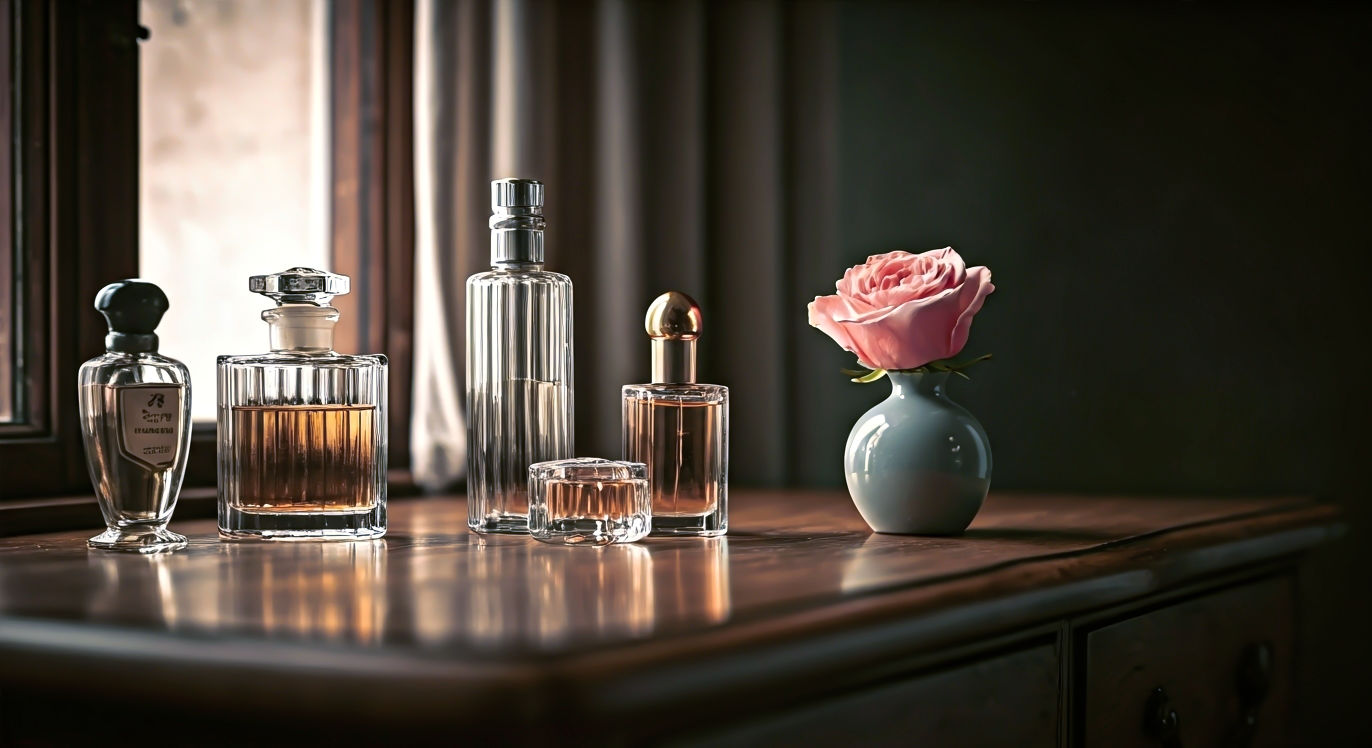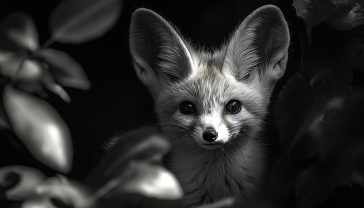The Scent of Time: A Guide to the World of Perfume
From Chanel No. 5 to niche British brands, this is your ultimate guide to understanding perfume, finding a signature scent, and wearing it with confidence.

This post may contain affiliate links. If you make a purchase through these links, we may earn a commission at no additional cost to you.
Think back for a moment. What does your childhood smell of? Is it the sweet, slightly dusty scent of your grandparents’ house? The sharp, green smell of freshly cut grass after a summer shower? Or maybe the comforting aroma of a parent’s signature perfume, a scent that meant they were home and all was right with the world.
Scent is a time machine. It’s a language we all understand without ever learning a single word. It’s the invisible thread that ties us to memories, people, and places more powerfully than any photograph. And at its most refined, this magic is bottled and given a name: perfume.
But for many of us, the world of fragrance can feel a bit intimidating. Step into the gleaming perfume hall of a big department store and you’re met with a wall of soundless noise – a hundred different scents all vying for your attention. You hear strange words like sillage, chypre, and eau de toilette. You see bottles that look like precious jewels and prices that make your eyes water. It’s easy to feel a bit lost, grab something familiar, or simply walk away.
This guide is here to change that. Forget the jargon and the mystery. We’re going to pull back the curtain on the art and science of scent. We’ll journey from the ancient Egyptians to the trend-setting labs of today, stopping off in the grand perfume houses of London along the way. We’ll break down exactly what goes into a bottle of perfume, how to find a scent that feels like you, and how to wear it with confidence. By the end, you won’t just understand perfume; you’ll have a new appreciation for the most powerful and personal of all our senses.
What Actually Is Perfume? The Basics Explained
Before we get into the flowery language, let’s get the basics straight. At its heart, a perfume is simply a mixture of fragrant essential oils or aroma compounds, fixatives, and solvents, usually alcohol. The magic lies in the concentration of those oils, which determines how strong the scent is and how long it lasts.
Think of it like making a glass of squash. The more concentrate you use, the stronger the drink. It’s the same with perfume.
Understanding Fragrance Concentrations
You’ve definitely seen the labels: Eau de Parfum, Eau de Toilette. They aren’t just fancy French phrases; they’re a simple guide to scent strength.
- Extrait de Parfum (or Parfum/Perfume Extract): This is the strongest stuff, the neat squash. It contains 20-30% perfume oil. It’s incredibly potent, and a tiny dab can last all day and into the night. It’s also the most expensive.
- Eau de Parfum (EDP): This is the most common concentration you’ll find, especially for women’s fragrances. With 15-20% oil, it’s a powerful, long-lasting scent that’s perfect for everyday wear if you want to make an impression.
- Eau de Toilette (EDT): A lighter, more refreshing option, with 5-15% oil. It’s great for work or warmer weather when you don’t want something too overpowering. It usually lasts for a few hours before it needs a top-up.
- Eau de Cologne (EDC): Originally referring to a specific style of fresh, citrus-based scent from Cologne, Germany, this term now describes a very light concentration of 2-4% oil. It gives you a quick blast of freshness but fades fast.
- Eau Fraiche: The most diluted of them all, with just 1-3% oil. The name means “fresh water,” and that’s exactly what it is – a light mist of scent to refresh you on a hot day.
The takeaway? If you want your scent to last from your morning commute on the Tube to after-work drinks in Soho, an EDP is your best bet. If you just want a light spritz for a summer afternoon in the park, an EDT or EDC will do nicely.
The Life of a Scent: The Fragrance Pyramid
Perfume isn’t a single, static smell. It’s a story that unfolds on your skin over time. Perfumers, often called ‘Noses’, carefully structure their creations to evolve in three stages. This is known as the fragrance pyramid.
- Top Notes (The Introduction): This is your first impression, the bright, sparkling opening. These notes are made of small, light molecules that burst into the air as soon as you spray them. They’re designed to grab your attention, but they’re also the first to fade, usually within 15 minutes. Think of zesty citrus fruits like lemon and bergamot, fresh herbs like mint, or light florals like lavender.
- Middle Notes (The Heart): Once the top notes have danced away, the heart of the fragrance emerges. These notes form the main character of the scent and last for a few hours. They are usually fuller, richer, and more rounded. This is where you’ll find the big floral bouquets of rose and jasmine, spicy notes like cinnamon and nutmeg, or green notes like freshly cut grass. The heart is what makes a perfume memorable.
- Base Notes (The Lasting Impression): These are the final notes to appear, emerging as the heart notes fade. They are made of large, heavy molecules that evaporate slowly, giving the perfume its depth and longevity. They are the anchor of the fragrance, the scent that lingers on your clothes the next day. Common base notes include rich, comforting smells like vanilla, sandalwood, cedarwood, musk, and amber.
A great perfume is a seamless blend of these three layers, a journey that takes you from a bright beginning to a warm, lingering end.
A Whiff of History: Perfume Through the Ages
The story of perfume is as old as civilization itself. It’s a tale of gods, kings, queens, and chemists, stretching from the banks of the Nile to the cobbled streets of London.
From Ancient Rituals to Roman Baths
Our love affair with scent began in the ancient world, where fragrance was a link to the divine. The very word “perfume” comes from the Latin per fumum, meaning “through smoke.” The first perfumes were incenses – fragrant resins like frankincense and myrrh – burned as offerings to the gods in Mesopotamia and Egypt. The Egyptians were obsessed with scent, using it in everything from religious ceremonies to daily hygiene and complex embalming rituals.
The Romans took this love of fragrance and turned it up to eleven. They perfumed everything: their bodies, their hair, their clothes, their homes, and even their pets and the fountains in their public squares. After a visit to the public baths, a wealthy Roman would be anointed with fragrant oils from head to toe.
The Perfumed Courts of Europe
After the fall of Rome, the art of perfumery was kept alive and refined in the Arab world. They perfected the process of distillation, allowing them to extract essential oils from flowers with incredible purity. When the Crusaders returned to Europe, they brought these exotic new scents and techniques with them.
Perfume truly took hold in the royal courts. In the 16th century, Queen Elizabeth I couldn’t stand bad smells. She demanded that her palaces be scented with sweet herbs and pomanders – little balls of aromatic spices – were carried to ward off nasty niffs and disease.
By the 18th century, France had become the centre of the perfume world, with the court of King Louis XV known as la cour parfumée (the perfumed court). But Britain was developing its own proud tradition. In 1730, a man named Juan Famenias Floris opened a shop at 89 Jermyn Street in London, selling exquisite perfumes, combs, and razors. Floris is still there today, and it remains the oldest English retailer of fragrance and toiletries. They hold a Royal Warrant from the Queen, a mark of the highest quality.
The 19th century saw the arrival of another iconic British brand. In 1870, a Cornish barber named William Penhaligon moved to London and became the court barber to Queen Victoria. Inspired by the smells of the Turkish baths next to his shop, he created his first fragrance, Hammam Bouquet. Penhaligon’s quickly became a favourite of the aristocracy, known for its classic English scents.
The 20th Century: Couture and Chemistry
The real revolution in perfume came in the 20th century, thanks to two things: fashion designers and science.
In 1921, the Parisian couturier Gabrielle “Coco” Chanel launched a fragrance that would change everything. She wanted a scent that was clean, modern, and sophisticated, something for the new, liberated woman. The result was Chanel No. 5. What made it so radical was its heavy use of aldehydes, a new class of synthetic molecules that gave the fragrance a sparkling, abstract, champagne-like fizz that was completely different from the simple floral scents of the time.
This was the birth of modern perfumery. Designers like Christian Dior, Nina Ricci, and Yves Saint Laurent followed suit, launching fragrances that became as famous as their clothes. At the same time, scientists were creating incredible new synthetic ingredients in labs, giving perfumers a vast new palette of smells to work with – scents that couldn’t be captured from nature.
The Perfumer’s Palette: Where Do Scents Come From?
A perfumer is like a composer, but instead of musical notes, they use scents. Their palette contains hundreds, sometimes thousands, of ingredients, drawn from both the natural world and the laboratory.
Gifts from Nature
For centuries, all perfumes were made from natural ingredients. They are the soul of perfumery, offering a complexity and richness that can be hard to replicate.
- Flowers: The most famous perfume ingredient. Roses from Bulgaria, jasmine from Grasse in France, heady tuberose from India, and creamy ylang-ylang from the Philippines. It takes a huge amount of flowers to produce a tiny amount of oil – over 10,000 jasmine blossoms are needed for just one millilitre of absolute.
- Woods and Mosses: These provide the earthy, grounding backbone for many scents. Think of creamy sandalwood, dry and smoky cedarwood, and damp, earthy oakmoss.
- Resins and Balsams: These are sticky saps that ooze from the bark of trees. They have warm, sweet, and comforting smells. Frankincense, myrrh, and amber are some of the most ancient and beloved.
- Spices and Herbs: From warm, sweet cinnamon and vanilla to aromatic lavender and fresh rosemary, the kitchen cupboard is a treasure trove of scents.
- Fruits: The zesty, uplifting scents of citrus fruits like bergamot, lemon, and orange are usually extracted from the peel. They give perfumes their initial sparkle.
- Animalics (The Controversial Ones): Historically, some of the most prized ingredients came from animals – musk from the musk deer, civet from the civet cat, and ambergris, a waxy substance from the digestive system of sperm whales. These ingredients have incredible depth and staying power. Thankfully, for ethical reasons, these have now been almost entirely replaced by brilliant synthetic versions that mimic their scent without harming any animals.
The Magic of Molecules
While we love the romance of natural ingredients, modern perfumery would be impossible without synthetics. These are aroma molecules created in a lab. They can be used to replicate natural smells, create entirely new scents that don’t exist in nature, and make perfumes more stable, long-lasting, and affordable.
An aldehyde, as we saw with Chanel No. 5, can add sparkle and brightness. A molecule called ISO E Super gives a velvety, woody, skin-like warmth that is famously the star of the cult perfume Molecule 01. Synthetics are not a “cheap” or “fake” alternative; they are essential tools that give perfumers incredible creative freedom.
Navigating the World of Scent: The Fragrance Families
With thousands of perfumes out there, how do you even begin to find one you like? The best place to start is with the fragrance families. Just like you might know you prefer red wine to white, you can learn which family of scents you’re naturally drawn to. The most commonly used system is the Fragrance Wheel, developed by scent expert Michael Edwards.
It divides all perfumes into four main families, with several sub-families within them.
1. Floral
This is the biggest and most popular family, especially in women’s perfumery. From the scent of a single flower (soliflore) to a huge mixed bouquet, these are pretty, romantic, and feminine scents.
- Sub-families: Fruity (with added sweet fruits), Floral (pure flowers), Soft Floral (soft, powdery flowers like iris and violet), Floral Amber (flowers mixed with sweet spices).
- Think: A walk through a classic English rose garden, a bouquet of fresh freesias, the smell of honeysuckle on a summer evening.
- Iconic Examples: Dior J’adore, Marc Jacobs Daisy, Chanel No. 5.
2. Amber (Previously known as Oriental)
Rich, warm, spicy, and sensual, these are the heavy-hitters of the perfume world. They are exotic and opulent, perfect for evening wear and colder months. The name of this family is being updated from “Oriental” to “Amber” to be more inclusive.
- Sub-families: Soft Amber (warm incense and spices), Amber (rich resins like amber and frankincense), Woody Amber (amber notes mixed with earthy woods like patchouli and sandalwood).
- Think: A bustling spice market, the sweet smell of incense in a temple, a cosy fireside with a vanilla candle burning.
- Iconic Examples: Guerlain Shalimar, Yves Saint Laurent Opium, Tom Ford Black Orchid.
3. Woody
Dominated by the scents of woods and moss, these fragrances are warm, dry, earthy, and elegant. Often found in men’s colognes, but increasingly popular in unisex and women’s scents too.
- Sub-families: Woods (classic woods like cedar and vetiver), Mossy Woods (damp, earthy scents with oakmoss), Dry Woods/Leather (smoky, leathery scents).
- Think: A walk through a pine forest after the rain, the smell of a freshly sharpened pencil, a well-worn leather jacket.
- Iconic Examples: Terre d’Hermès, Penhaligon’s The Tragedy of Lord George, Santal 33.
4. Fresh
This family covers all things bright, zesty, and clean. These are uplifting, energetic scents that are easy to wear, especially during the day and in summer.
- Sub-families: Aromatic (fresh herbs like lavender and rosemary mixed with woods), Citrus (lemon, bergamot, grapefruit), Water (the smell of sea spray or rain), Green (the scent of freshly cut grass or crushed leaves).
- Think: A gin and tonic with a slice of lime, the sea breeze on the Cornish coast, a herb garden in the morning dew.
- Iconic Examples: Acqua di Gio, Jo Malone London Lime Basil & Mandarin, Davidoff Cool Water.
A special category: One famous family that sits between the others is Chypre (pronounced “sheep-ra”). Named after a 1917 perfume by Coty called Chypre, these are sophisticated scents built on a specific structure: a citrus top note (usually bergamot), a floral heart, and a woody, mossy base (oakmoss and patchouli). They smell rich, elegant, and a little bit mossy. Think Mitsouko by Guerlain or Aromatics Elixir by Clinique.
Your Practical Guide to Perfume
Now you know the theory, it’s time for the fun part: finding and wearing your perfect scent.
How to Find “The One” (or a Few)
The idea of a single “signature scent” is lovely, but don’t feel pressured. Many people prefer having a fragrance wardrobe – a collection of different scents for different moods, seasons, and occasions. You might want a light, fresh scent for the office, a romantic floral for a date night, and a warm, cosy amber for winter weekends.
Here’s how to start your search:
- Do Your Homework: Think about the smells you already love in everyday life. Is it the smell of coffee and vanilla in your favourite café? The salty air at the beach? The smell of roses in your garden? This can give you a clue as to which fragrance family you might like.
- Test the Right Way: The golden rule of perfume shopping is always test on your skin. The scent you smell on a paper strip will be different from how it smells on you, because your unique body chemistry (your diet, your skin type, even your hormones) will affect how the fragrance develops.
- Don’t Rush It: When you go shopping, don’t try more than three or four scents at a time. Your nose will get overwhelmed, a bit like being snow-blind. Spray one on each wrist and maybe one on the inside of each elbow.
- Live with It: This is the most important step. Don’t buy a perfume straight after spraying it. The top notes you smell in the first few minutes might be gorgeous, but they’ll be gone before you’ve even left the shop. You need to wait for the scent to dry down and for the heart and base notes to come through. Go for a walk, have a cup of tea, and smell your wrist every half an hour. How does it change? Do you still love it after four hours? This is the true test.
The Art of Application: How to Wear It Well
You’ve found a scent you love. Now, how do you make it last and ensure you’re smelling great, not overwhelming?
- Target Pulse Points: Perfume is activated by heat. Spray it on your pulse points, where your blood vessels are closest to the skin’s surface. These include the wrists, the base of the neck, behind the ears, inside the elbows, and behind the knees.
- Don’t Rub!: We all do it – spritz our wrists and then rub them together. Stop! Rubbing creates friction that heats up the skin and can crush the delicate top and middle notes, changing the way the perfume was designed to smell. Just spray and let it air dry.
- Moisturise First: Perfume lasts longer on well-hydrated skin. For maximum longevity, apply an unscented lotion before you spritz your fragrance.
- Spray Your Hair (Carefully): Your hair holds scent beautifully. Lightly mist your hairbrush with perfume and brush it through. Don’t spray directly onto your hair, as the alcohol can be drying.
- Less Is More: Remember, you might get used to your own scent during the day (this is called nose fatigue), but others can still smell it. For an EDP, two or three sprays are usually plenty. You want to create a gentle aura of scent, not a fog. The rule is that someone should only be able to smell your perfume when they are standing within arm’s length of you.
Storing Your Collection
Perfume is a delicate thing. Its biggest enemies are heat, light, and air. To keep your fragrances fresh for as long as possible (they can last for years if cared for properly), store them in a cool, dark, and dry place. The bathroom cabinet, with all its heat and humidity from the shower, is actually one of the worst places. A drawer in your bedroom or a closed cupboard is perfect.
The Modern Scent Scene: Designer, Niche, and Beyond
The world of perfume today is more exciting than ever. The old rules are gone. Men are wearing florals, women are wearing deep, woody scents, and fascinating new brands are popping up all the time.
- Designer: These are the brands you see in every department store, from fashion houses like Chanel, Dior, and Gucci to big beauty companies. They are designed to have mass appeal and are a fantastic place to start your fragrance journey.
- Niche: These are smaller perfume houses that focus on the art of fragrance above all else. They are often more creative, unusual, and daring than designer brands. They use high-quality ingredients and tell interesting stories with their scents. British niche brands like Jo Malone London (which started niche before being bought by Estée Lauder), Penhaligon’s, Miller Harris, and Roja Parfums are world-renowned.
- Indie: These are the true artisans. Often run by a single self-taught perfumer, they create small batches of highly original fragrances. It’s a world of incredible passion and creativity.
The lines are blurring, but the key takeaway is that there is a whole universe of scent out there to explore beyond the best-seller list. Don’t be afraid to step into a smaller, independent perfume shop like Les Senteurs or Bloom in London. The staff are incredibly knowledgeable and passionate, and they can guide you to scents you would never have discovered on your own.
A Final Thought on Fragrance
Perfume is so much more than just a nice smell in a fancy bottle. It’s a form of self-expression, an invisible accessory that says something about who you are, or who you want to be today. It can be a confidence boost before a big meeting, a comfort on a difficult day, or a joyful celebration of a special moment.
The most important rule in the world of fragrance is that there are no rules. If you love a scent, wear it. It doesn’t matter if it’s marketed to men or women, if it’s a cheap-as-chips classic or an eye-wateringly expensive niche creation. All that matters is how it makes you feel.
So, go on a journey of discovery. Be curious. Spray that strange-sounding scent. Ask for samples. Pay attention to the smells around you. Find the scents that tell your story. Because in the end, the best perfume in the world is the one that brings a smile to your face.
Further Reading
For those wishing to delve deeper into the world of fragrance, here are some of the most respected resources available:
- Fragrantica: An enormous online encyclopedia of perfumes, a perfume magazine, and a community of perfume lovers. You can find detailed notes, reviews, and histories for almost any perfume ever made. (https://www.fragrantica.com/)
- Basenotes: One of the oldest and most respected online fragrance communities, with a vast forum, news, and detailed reviews. A fantastic resource for in-depth discussion. (https://www.basenotes.net/)
- The Perfume Society: A UK-based organisation dedicated to helping people discover the world of scent. They offer discovery boxes, workshops, and a wealth of beautifully written articles. (https://perfumesociety.org/)
- Now Smell This: A long-running and highly respected perfume blog with news, reviews of new fragrances, and guides to the classics. (https://nstperfume.com/)






